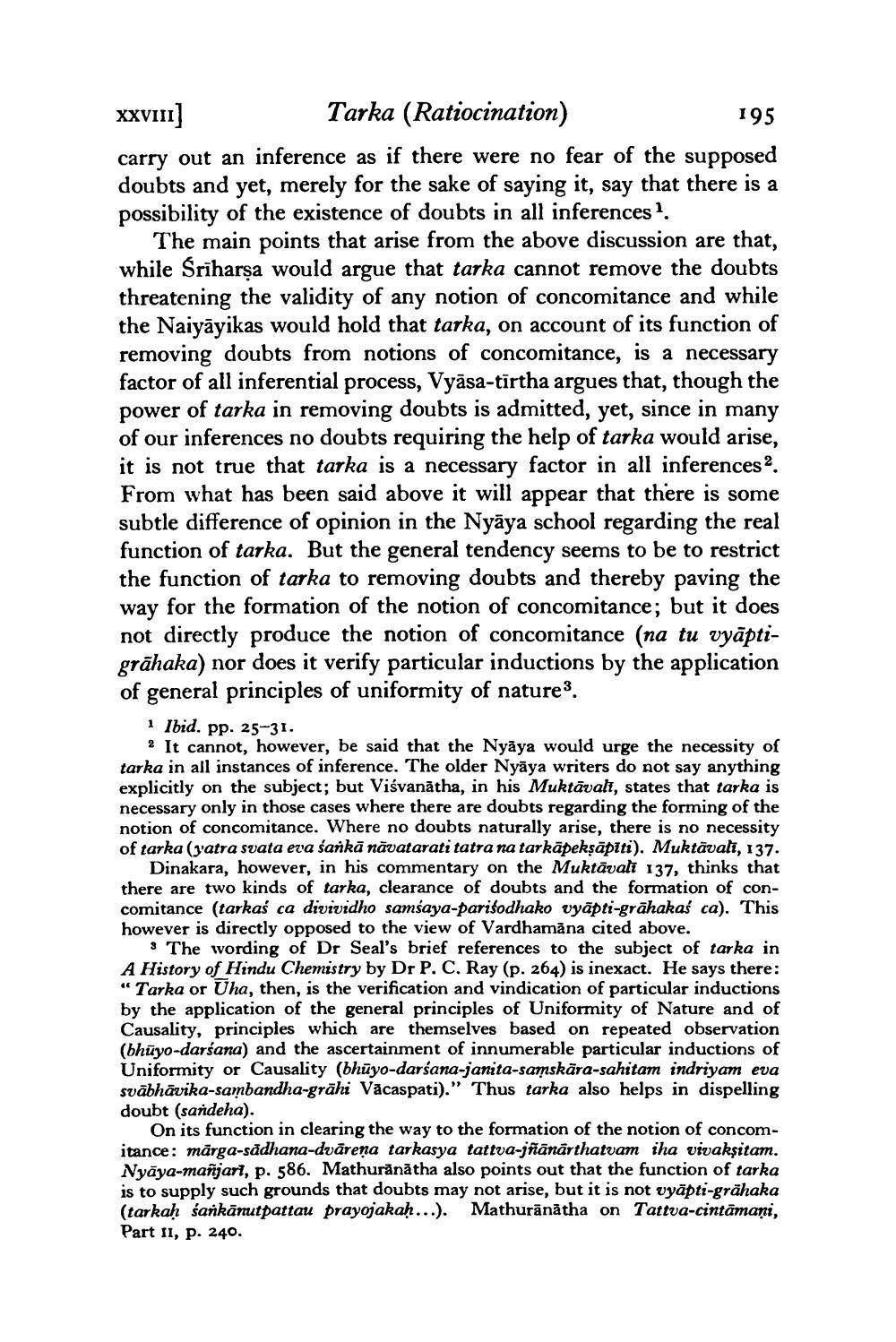________________
xxv11] Tarka (Ratiocination)
195 carry out an inference as if there were no fear of the supposed doubts and yet, merely for the sake of saying it, say that there is a possibility of the existence of doubts in all inferences ?
The main points that arise from the above discussion are that, while Sriharsa would argue that tarka cannot remove the doubts threatening the validity of any notion of concomitance and while the Naiyāyikas would hold that tarka, on account of its function of removing doubts from notions of concomitance, is a necessary factor of all inferential process, Vyāsa-tirtha argues that, though the power of tarka in removing doubts is admitted, yet, since in many of our inferences no doubts requiring the help of tarka would arise, it is not true that tarka is a necessary factor in all inferences From what has been said above it will appear that there is some subtle difference of opinion in the Nyāya school regarding the real function of tarka. But the general tendency seems to be to restrict the function of tarka to removing doubts and thereby paving the way for the formation of the notion of concomitance; but it does not directly produce the notion of concomitance (na tu vyāptigrāhaka) nor does it verify particular inductions by the application of general principles of uniformity of nature3.
1 Ibid. pp. 25-31.
2 It cannot, however, be said that the Nyāya would urge the necessity of tarka in all instances of inference. The older Nyāya writers do not say anything explicitly on the subject; but Viśvanātha, in his Muktāvali, states that tarka is necessary only in those cases where there are doubts regarding the forming of the notion of concomitance. Where no doubts naturally arise, there is no necessity of tarka (Jatra svata eva sarkā nāvatarati tatra na tarkāpeksāpiti). Muktavali, 137.
Dinakara, however, in his commentary on the Muktāvali 137, thinks that there are two kinds of tarka, clearance of doubts and the formation of concomitance (tarkaś ca divividho samsaya-parisodhako vyāpti-grāhakaś ca). This however is directly opposed to the view of Vardhamāna cited above.
3 The wording of Dr Seal's brief references to the subject of tarka in A History of Hindu Chemistry by Dr P. C. Ray (p. 264) is inexact. He says there: “Tarka or Uha, then, is the verification and vindication of particular inductions by the application of the general principles of Uniformity of Nature and of Causality, principles which are themselves based on repeated observation (bhūyo-darśana) and the ascertainment of innumerable particular inductions of Uniformity or Causality (bhūyo-darśana-janita-samskāra-sahitam indriyam eva svābhāvika-sambandha-grāhi Vacaspati)." Thus tarka also helps in dispelling doubt (sardeha).
On its function in clearing the way to the formation of the notion of concomitance: märga-sadhana-dvārena tarkasya tattva-jñānārthatvam iha vivaksitam. Nvāva-mañjari, p. 586. Mathuranātha also points out that the function of tarka is to supply such grounds that doubts may not arise, but it is not vyāpti-grähaka (tarkaḥ sankānutpattau prayojakaḥ...). Mathurānātha on Tattva-cintāmani, Part II, p. 240.
divividh. Clearancety on the




